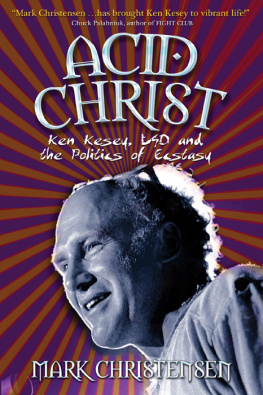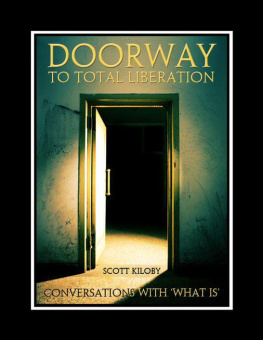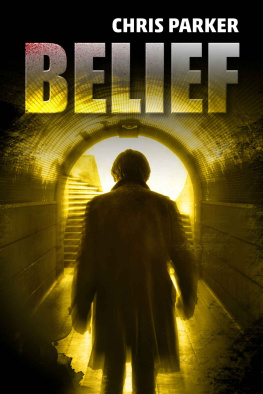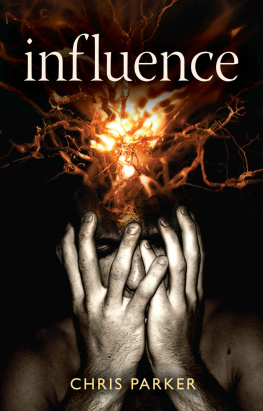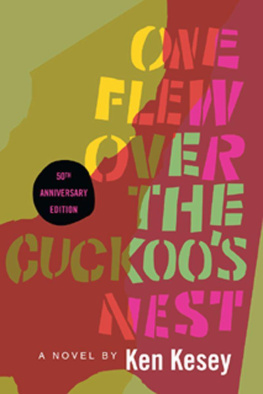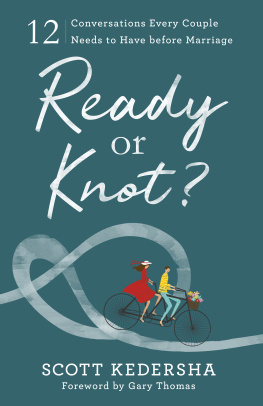Scott F. Parker - Conversations with Ken Kesey
Here you can read online Scott F. Parker - Conversations with Ken Kesey full text of the book (entire story) in english for free. Download pdf and epub, get meaning, cover and reviews about this ebook. year: 2014, publisher: University Press of Mississippi, genre: Art. Description of the work, (preface) as well as reviews are available. Best literature library LitArk.com created for fans of good reading and offers a wide selection of genres:
Romance novel
Science fiction
Adventure
Detective
Science
History
Home and family
Prose
Art
Politics
Computer
Non-fiction
Religion
Business
Children
Humor
Choose a favorite category and find really read worthwhile books. Enjoy immersion in the world of imagination, feel the emotions of the characters or learn something new for yourself, make an fascinating discovery.

- Book:Conversations with Ken Kesey
- Author:
- Publisher:University Press of Mississippi
- Genre:
- Year:2014
- Rating:3 / 5
- Favourites:Add to favourites
- Your mark:
- 60
- 1
- 2
- 3
- 4
- 5
Conversations with Ken Kesey: summary, description and annotation
We offer to read an annotation, description, summary or preface (depends on what the author of the book "Conversations with Ken Kesey" wrote himself). If you haven't found the necessary information about the book — write in the comments, we will try to find it.
Conversations with Ken Kesey — read online for free the complete book (whole text) full work
Below is the text of the book, divided by pages. System saving the place of the last page read, allows you to conveniently read the book "Conversations with Ken Kesey" online for free, without having to search again every time where you left off. Put a bookmark, and you can go to the page where you finished reading at any time.
Font size:
Interval:
Bookmark:
Conversations with Ken Kesey
Literary Conversations Series
Peggy Whitman Prenshaw
General Editor
with Ken Kesey
Edited by Scott F. Parker

Books by Ken Kesey
One Flew Over the Cuckoos Nest, Viking, 1962.
Sometimes a Great Notion, Viking, 1964.
Keseys Garage Sale, Viking, 1973.
Kesey, Northwest Review of Books, 1977 (Edited by Michael Strelow).
The Day After Superman Died, Lord John Press, 1980.
Demon Box, Viking, 1986.
The Further Inquiry, Viking, 1990.
Caverns (by O. U. Levon, a joint pseudonym for Ken Kesey, Robert Bluckner, Ben Bochner, James Finley, Jeff Forester, Bennett Huffman, Lynn Jeffress, Neil Lindstrom, H. Highwater Powers, Jane Sather, Charles Varani, Meredith Wadley, Lidia Yukman, and Ken Zimmerman), Penguin, 1990.
Little Tricker the Squirrel Meets Big Double the Bear, Viking, 1990.
The Sea Lion, Viking, 1991.
Sailor Song, Viking, 1992.
Last Go Round: A Real Western, (with Ken Babbs), Viking, 1994.
Keseys Jail Journal: Cut the M*********** Loose, Viking, 2003.
www.upress.state.ms.us
The University Press of Mississippi is a member of the Association of American University Presses.
Copyright 2014 by University Press of Mississippi
All rights reserved
Manufactured in the United States of America
First printing 2014
Library of Congress Cataloging-in-Publication Data
Kesey, Ken.
Conversations with Ken Kesey / edited by Scott F. Parker.
pages cm. (Literary conversations series)
Includes index.
ISBN 978-1-61703-970-6 (cloth : alk. paper) ISBN 978-1-61703-982-9 (pbk. : alk. paper) ISBN 978-1-61703-971-3 (ebook) 1. Kesey, KenInterviews. 2. Novelists, American20th centuryInterviews. I. Parker, Scott F. editor of compilation. II. Title.
PS3561.E667Z46 2014
813.54dc23
[B] 2013035940
British Library Cataloging-in-Publication Data available
Though he made his reputation as a writer, it is as a psychedelic guru that Ken Keseys reputation largely maintainsand how one assesses Kesey as a cultural figure tends to have much to do with the amount and kind of value one recognizes in the psychedelic movement. Was it a noble experiment, regardless of its outcomes? Was it a lifestyle of radical self-indulgence? Surely, any honest reading of the 60s must comprise both extremes and find its center of gravity somewhere between, but its easier to think in binary of poles, so Keseyas the public face of acid and the unmoved mover of the psychedelic movementgets read as a personification of the decade and therefore becomes equally polarized: either he was an unprecedented visionary whose ambitions couldnt be contained by mere literature or he was a talented but undisciplined writer who got swept up in the times.
Keseys two great novels, One Flew Over the Cuckoos Nest and Sometimes a Great Notion, were published in 1962 and 1964, respectively, while he was still in his twenties. When he turned away from writing after his second book it was to turn toward film and the idea of making from his life a living work of art. Film he considered a better medium than writing for capturing the texture of contemporary life, often repeating a version of If Shakespeare were alive today, he wouldnt be using the quill pen. The idea that Kesey would rather be a lightning rod than a seismograph was due as much to Neal Cassady, whose influence on Kesey probably cannot be overstated, as it was to the drugs. The hiatus from writing lasted into the 70s, but after settling on a farm in Pleasant Hill, Oregon, with his family, Kesey found himself returning to writing, explaining to Paul Krassner in an interview: I was counting on the millennium. Now I guess Im tired of waiting. Kesey continued to write and publish, however irregularly, over the remainder of his life, but its still for his early novels that hes known as an author.
And yet, resonate in the culture as those booksespecially Cuckoos Nest, thanks to its film adaptationdo, it is primarily for what happened in the mid-60s after the publication of Sometimes a Great Notion that Kesey continues to hold a central place in our cultural memory. Theres no talking about Keseyor talking with Keseywithout talking drugs.
Marijuana and hallucinogens were central to Keseys writing as early as Cuckoos Nest. Hed been involved in drug experiments at the Menlo Park Veterans Hospital for years already when the book was published and stated that its first pages and the idea for Bromden, the Indian narrator, came to him on peyote. In an interview with Gordon Lish he compares the benefits of drugs for him to those James Joyce gained from his eyeglasses. But after Sometimes a Great Notion writing stopped seeming like an adequate means of expression for Kesey, and he began to think of the bus Furthur as his primary artistic product. Its with Cassady at the wheel, a refrigerator full of acid-infused orange juice in the back, and the whole country in front him, that Kesey says, Novels are a dime a dozen, but theres only one bus Furthur.
Not everyone will agree, of course, that a psychedelic bus trip is worth more than the books that were presumably sacrificed to it, but if we take seriously Keseys idea that Furthur was an artistic enterprise, not just a recreational one, then we can entertain the possibility that Kesey, not Tom Wolfe, is the author of the accompanying Kesey persona, even if it was primarily Wolfes The Electric Kool-Aid Acid Test in 1968 that made Keseys escapades and charisma known to the public. Kesey, then, by authoring the bus and his role as lightning rod to Wolfes seismograph, can be seen to have produced a work of art that wont conform to the dimensions of a book. But in transgressing any boundary to his work, he made his creation, his self, into one of our last writer-heroes. The irony is that he was a hero mostly insofar as he stopped being known as a writer: or, the character overtook its creator, and from that time on the author struggled to be anything but his persona.
Keseys publications after Great Notion were in part different kinds of attempts to get out from under the persona. He called the persona Devlin Deboree and dumped what he hoped was all of it in Demon Box; he tried co-writing novels with students and friends; he turned to performance and storytelling and childrens writing; and, twenty-eight years after Great Notion, he published one more big novel, Sailor Song, an attempt to return to an old-fashioned, story-based book.
In a 1993 interview with Dan McCue, Kesey said that he wouldnt have let Tom Wolfe do [Kool-Aid] if I had known what I know now. But however we divide responsibility for the aftermath of Kool-Aid, it was Kesey alone who suffered under it. In the later interviews its palpable how much the history weighs on Kesey, as he alternates between celebration and the suggestion of regret.

Despite the tolls of fame and drugs on Kesey, these interviews reveal an author, an artist, a person, of utmost intelligence and compassion, deeply engaged with and committed to the world around him. No matter the occasion, he speaks or writes playfully in parables full of the folksy wisdom he cultivated in Oregon coming of age amidst a storytelling family.
I have attempted to collect here interviews that represent the full range of Keseys time in the public eye: from his first major interview with Gordon Lish between the publication of his two early novels (in which we see Kesey at his most writerly) to his last interview reminiscing about the Grateful Dead; from short newspaper pieces to long, in-depth portraits.
Next pageFont size:
Interval:
Bookmark:
Similar books «Conversations with Ken Kesey»
Look at similar books to Conversations with Ken Kesey. We have selected literature similar in name and meaning in the hope of providing readers with more options to find new, interesting, not yet read works.
Discussion, reviews of the book Conversations with Ken Kesey and just readers' own opinions. Leave your comments, write what you think about the work, its meaning or the main characters. Specify what exactly you liked and what you didn't like, and why you think so.




